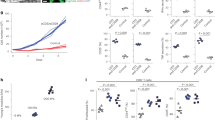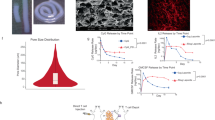Abstract
The efficacy of adoptive T-cell therapies based on chimaeric antigen receptors (CARs) is limited by the poor proliferation and persistence of the engineered T cells. Here we show that a subcutaneously injected biodegradable scaffold that facilitates the infiltration and egress of specific T-cell subpopulations, which forms a microenvironment mimicking features of physiological T-cell activation, enhances the antitumour activity of pre-administered CAR-T cells. CAR-T-cell expansion, differentiation and cytotoxicity were driven by the scaffold’s incorporation of co-stimulatory bound ligands and soluble molecules, and depended on the types of co-stimulatory molecules and the context in which they were presented. In mice with aggressive lymphoma, a single, local injection of the scaffold following non-curative CAR-T-cell dosing led to more persistent memory-like T cells and extended animal survival. Injectable biomaterials with optimized ligand presentation may boost the therapeutic performance of CAR-T-cell therapies.




Similar content being viewed by others
Data availability
The data supporting the findings in this study are available within the paper and its Supplementary Information. All data generated in this study are available from the corresponding author on reasonable request. Source data are provided with this paper.
References
Levine, B. L., Miskin, J., Wonnacott, K. & Keir, C. Global manufacturing of CAR T cell therapy. Mol. Ther. Methods Clin. Dev. 4, 92–101 (2017).
Majzner, R. G. & Mackall, C. L. Clinical lessons learned from the first leg of the CAR T cell journey. Nat. Med. 25, 1341–1355 (2019).
Hernandez-Lopez, R. A. et al. T cell circuits that sense antigen density with an ultrasensitive threshold. Science 371, 1166–1171 (2021).
James, J. R. Tuning ITAM multiplicity on T cell receptors can control potency and selectivity to ligand density. Sci. Signal. 11, eaan1088 (2018).
Feucht, J. et al. Calibration of CAR activation potential directs alternative T cell fates and therapeutic potency. Nat. Med. 25, 82–88 (2019).
Weber, E. W. et al. Transient ‘rest’ restores functionality in exhausted CAR-T cells via epigenetic remodeling. Science 372, eaba1786 (2021).
Good, Z. et al. Proliferation tracing with single-cell mass cytometry optimizes generation of stem cell memory-like T cells. Nat. Biotechnol. 37, 259–266 (2019).
Lynn, R. C. et al. c-Jun overexpression in CAR T cells induces exhaustion resistance. Nature 576, 293–300 (2019).
Lim, W. A. & June, C. H. The principles of engineering immune cells to treat cancer. Cell 168, 724–740 (2017).
Rafiq, S., Hackett, C. S. & Brentjens, R. J. Engineering strategies to overcome the current roadblocks in CAR T cell therapy. Nat. Rev. Clin. Oncol. 17, 147–167 (2020).
Eyquem, J. et al. Targeting a CAR to the TRAC locus with CRISPR/Cas9 enhances tumour rejection. Nature 543, 113–117 (2017).
Ma, L. et al. Enhanced CAR–T cell activity against solid tumors by vaccine boosting through the chimeric receptor. Science 365, 162–168 (2019).
Reinhard, K. et al. An RNA vaccine drives expansion and efficacy of claudin-CAR-T cells against solid tumors. Science 367, 446–453 (2020).
Satthaporn, S. et al. Dendritic cells are dysfunctional in patients with operable breast cancer. Cancer Immunol. Immunother. 53, 510–518 (2004).
Bandola-Simon, J. & Roche, P. A. Dysfunction of antigen processing and presentation by dendritic cells in cancer. Mol. Immunol. 113, 31–37 (2019).
Giavridis, T. et al. CAR T cell-induced cytokine release syndrome is mediated by macrophages and abated by IL-1 blockade. Nat. Med. 24, 731–738 (2018).
Coon, M. E., Stephan, S. B., Gupta, V., Kealey, C. P. & Stephan, M. T. Nitinol thin films functionalized with CAR-T cells for the treatment of solid tumours. Nat. Biomed. Eng. 4, 195–206 (2020).
Cheung, A. S., Zhang, D. K. Y., Koshy, S. T. & Mooney, D. J. Scaffolds that mimic antigen-presenting cells enable ex vivo expansion of primary T cells. Nat. Biotechnol. 36, 160–169 (2018).
Zhang, D. K. Y., Cheung, A. S. & Mooney, D. J. Activation and expansion of human T cells using artificial antigen-presenting cell scaffolds. Nat. Protoc. https://doi.org/10.1038/s41596-019-0249-0 (2020).
Kim, J. et al. Injectable, spontaneously assembling, inorganic scaffolds modulate immune cells in vivo and increase vaccine efficacy. Nat. Biotechnol. 33, 61–69 (2014).
Li, A. W. et al. A facile approach to enhance antigen response for personalized cancer vaccination. Nat. Mater. 17, 528 (2018).
Dellacherie, M. O. et al. Single-shot mesoporous silica rods scaffold for induction of humoral responses against small antigens. Adv. Funct. Mater. 30, 2002448 (2020).
Deng, Q. et al. Characteristics of anti-CD19 CAR T cell infusion products associated with efficacy and toxicity in patients with large B cell lymphomas. Nat. Med. https://doi.org/10.1038/s41591-020-1061-7 (2020).
Li, W. A. et al. The effect of surface modification of mesoporous silica micro-rod scaffold on immune cell activation and infiltration. Biomaterials 83, 249–256 (2016).
Brentjens, R. J. et al. Safety and persistence of adoptively transferred autologous CD19-targeted T cells in patients with relapsed or chemotherapy refractory B-cell leukemias. Blood 118, 4817–4828 (2011).
Agarwalla, P. et al. Bioinstructive implantable scaffolds for rapid in vivo manufacture and release of CAR-T cells. Nat. Biotechnol. 40, 1250–1258 (2022).
Zhang, D. K. Y. et al. Enhancing CAR-T cell functionality in a patient-specific manner. Nat. Commun. 14, 506 (2023).
Cruz, C. R. Y. et al. Infusion of donor-derived CD19-redirected virus-specific T cells for B-cell malignancies relapsed after allogeneic stem cell transplant: a phase 1 study. Blood 122, 2965–2973 (2013).
Sockolosky, J. T. et al. Selective targeting of engineered T cells using orthogonal IL-2 cytokine-receptor complexes. Science 359, 1037–1042 (2018).
Bauer, C. A. et al. Dynamic Treg interactions with intratumoral APCs promote local CTL dysfunction. J. Clin. Invest. 124, 2425–2440 (2014).
Chen, M.-L. et al. Regulatory T cells suppress tumor-specific CD8 T cell cytotoxicity through TGF-β signals in vivo. Proc. Natl Acad. Sci. USA 102, 419–424 (2005).
Rosenberg, S. A. et al. Treatment of 283 consecutive patients with metastatic melanoma or renal cell cancer using high-dose bolus interleukin 2. JAMA 271, 907–913 (1994).
Raeber, M. E., Sahin, D., Karakus, U. & Boyman, O. A systematic review of interleukin-2-based immunotherapies in clinical trials for cancer and autoimmune diseases. EBioMedicine 90, 104539 (2023).
Dutcher, J. P. et al. High dose interleukin-2 (Aldesleukin) - expert consensus on best management practices-2014. J. Immunother. Cancer 2, 26 (2014).
Grosskopf, A. K. et al. Delivery of CAR-T cells in a transient injectable stimulatory hydrogel niche improves treatment of solid tumors. Sci. Adv. 8, eabn8264 (2022).
Acknowledgements
We thank A. Najibi for critical reading of the manuscript and D. Neuberg for statistical guidance; A. Cheung, O. Ali, Z. Good, N. Cerri, E. Smith, C. Louvet, C. Wu, M. Pezzone, E. Doherty, H. Ijaz, C. Johnson, D. White, M. Perez, E. Zigon, G. Cuneo and T. Ferrante for many important technical and scientific discussions. This work was supported by the Wyss Institute at Harvard University (D.J.M.), the Food and Drug Administration (grant number 5R01FD006589), and the National Institutes of Health under grant numbers R01 EB015498, R01 CA276459, and U01 CA214369. The content is solely the responsibility of the authors and does not necessarily represent the official views of the National Institutes of Health. D.K.Y.Z. acknowledges support from the Canadian Institutes of Health Research (CIHR). J.M.B. acknowledges support from the National Cancer Institute (grant number K00CA234959). Material characterization was performed at the Center for Nanoscale Systems (CNS) at Harvard University, which is supported by the National Science Foundation (grant number 1541979).
Author information
Authors and Affiliations
Contributions
D.K.Y.Z., J.M.B. and D.J.M. conceived the project. D.K.Y.Z., J.M.B., K.A.-B., Y.L., Y.B., I.d.L., M.C.S. and R.T. performed experiments. D.K.Y.Z. and J.M.B. analysed data and generated figures. D.K.Y.Z., J.M.B. and D.J.M. wrote the paper. All authors commented on the paper.
Corresponding author
Ethics declarations
Competing interests
D.J.M. is an inventor in patent applications Harvard University has filed in relation to the TES technology, which has been licensed to Lyell Immunopharma (US Patent App. 18/072,449). D.J.M. has stock in Lyell Immunopharma. D.J.M, D.K.Y.Z. and J.M.B. are listed as inventors in a patent application based on the findings of this study (WO 2023/147185). The other authors declare no competing interests.
Peer review
Peer review information
Nature Biomedical Engineering thanks **aoyuan Chen, Zhen Gu and Jonathan Schneck for their contribution to the peer review of this work.
Additional information
Publisher’s note Springer Nature remains neutral with regard to jurisdictional claims in published maps and institutional affiliations.
Extended data
Extended Data Fig. 1 TES dictates T-cell proliferation kinetics in vivo.
(a) Naïve, unstimulated, primary human T cells were labeled with CFSE and co-delivered subcutaneously with TES presenting αCD3/αCD28/IL-2 or without any ligands (labeled ‘blank’). T-cell proliferation as indicated by CFSE dilution of cells isolated from TES-containing explants at 5 days post injection. (b,c) Analysis of TES’ T-cell boosting capacity in different tumor burden contexts. Tumor-bearing animals (inoculated with 5 × 105 Raji-luc cells) were treated with either a sub-curative dose of 5 × 105 CAR-T cells or a curative dose of 1 × 106 CAR-T cells. TES were injected subcutaneously 5 days following CAR-T cell dosing, and circulating T cells in the blood were subsequently analyzed. (b) Frequency of CD3+ T cells in circulating blood. (c) Number of CD3+ T cells in the blood following subcutaneous scaffold injection under sub-curative CAR-T dosing conditions. (d, e) The capacity of injected material scaffolds to boost T-cell proliferation was evaluated in a xenograft lymphoma model. Animals were inoculated with 5 × 105 Raji-luc cells and treated 4 days afterwards with a curative dose of 1 × 106 CD19 CAR-T cells. (d) Scaffolds were injected into mice with baseline CAR-T, and human T cells were detected in αCD3/αCD28 presenting TES, while very few human T cells were detected in non-ligand-presenting ‘blank’ TES. Left: representative FACS plots showing enrichment of CD3+ T cells. (e) Expression of CD25 among T cells in day 14-explanted TES. Left: representative FACS histoplots. Data represents n = 3-4 mice per condition and mean ± s.e.m. and is representative of at least two experimental replicates. Comparisons in (d, e) were measured using unpaired Student’s T-tests with Welch’s correction for unequal s.d. Data in (b) represents mean ± s.e.m. of n = 5–7 mice.
Supplementary information
Supplementary Information
Supplementary figures and table.
Source data
Rights and permissions
Springer Nature or its licensor (e.g. a society or other partner) holds exclusive rights to this article under a publishing agreement with the author(s) or other rightsholder(s); author self-archiving of the accepted manuscript version of this article is solely governed by the terms of such publishing agreement and applicable law.
About this article
Cite this article
Zhang, D.K.Y., Brockman, J.M., Adu-Berchie, K. et al. Subcutaneous biodegradable scaffolds for restimulating the antitumour activity of pre-administered CAR-T cells. Nat. Biomed. Eng (2024). https://doi.org/10.1038/s41551-024-01216-4
Received:
Accepted:
Published:
DOI: https://doi.org/10.1038/s41551-024-01216-4
- Springer Nature Limited





